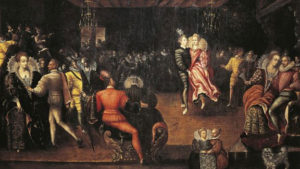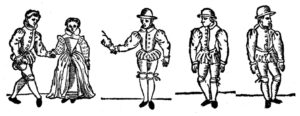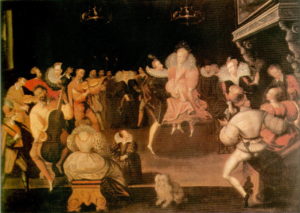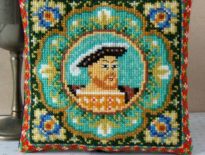Today is International Dance Day, a global celebration of dance. The International Dance Day website explains "This day is a celebration day for those who can see the value and importance of the art form “dance”, and acts as a wake-up-call for governments, politicians and institutions which have not yet recognised its value to the people and to the individual and have not yet realised its potential for economic growth."
To celebrate this day, we thought we'd share an article on 16th century dance. This article by Jane Moulder originally appeared in the February 2015 edition of Tudor Life Magazine.
In 2013 Miley Cyrus summoned disapproval and media outrage with a promotional video showing her “twerking”, thus sparking both a dance craze and a new word entry into the Oxford English Dictionary. However, twerking is just the latest in a very long list of dance styles and fashions that have scandalised polite society and created moral indignation, accompanied by loud tutting noises and the shaking of heads! In the 1950s, the Jitterbug was described as being “conceived in hell and brought forth by the brothel”. The Charleston, Can-Can and even the stately Waltz were all derided by society and the press when they first appeared. The Times, in 1816, went as far as saying that the waltz was “as far removed from the modest reserve which has hitherto been considered distinctive of English females”.
But moral outrage aimed at the latest dance fashion dates date back much further than the 1800s - in the 1560s it was "la volta" causing tongues to wag. The German, Johann Praetorius wrote:
"A new galliard, the volta, is a foreign dance in which they seize each other in lewd places and which was brought to France by conjurors from Italy. It is a whirling dance full of scandalous, beastly gestures and immodest movements. The volta is also responsible for the misfortune that innumerable murders and miscarriages are brought about by it".
I’m sure no murders were ever brought about by a dance but the volta is certainly a whirling dance and it was those movements that were considered very immodest at the time.
This reputation for the la volta being a risqué and immoral dance has been used to great effect in recent film and TV productions and the very mention of a “la volta” is a byword for sex and seduction. In the TV series The Tudors, Henry commands Anne Boleyn to dance the La Volta with him. She duly accepts and there follows an infamous scene where a very sexy seduction takes place between Henry and Anne interspersed with scenes of them dancing. However, there is a more than a small amount of artistic licence used because they are definitely not dancing a la volta according to its description. In fact, the dance hadn’t even appeared in England at this date! Also the music they dance to is a 13th century Spanish Cantiga, written in honour of the Virgin Mary. But then, The Tudors is not really about historical accuracy! Here's the clip:
Likewise, in the award winning film, “Elizabeth” starring Cate Blanchett, there is an equally seductive version of La Volta when Elizabeth commands Robert Dudley, Earl of Leicester to dance the la volta with her, accompanied by gasps of shock and delight by the surrounding courtiers - see below:
Again, the dance performed bears no relation to the true, shocking La Volta!
The term “la volta” is Italian in origin and means to turn, and that certainly describes one of the basic moves of the dance. La Volta may well have originated in Italy, where another similar dance called La Nizzarda has been described. However, it was in France that the dance became known and caused a sensation. It is thought to have been introduced to the French court by Catherine de Medici in the 1550s when she was married to Henri II. But it was during the reign of her son, Henri III, that the dance became really popular in 1570s and 1580s. This fashionable dance soon spread to the English court where it also shocked society.

A couple dancing la volta at a ball at the Court of Henri III (1551-1589)
One of the Ministers of the Reformed Church in France, Lambert Daneau, took particular exception to the dance as it made the couple dancing it the centre of attention and the gyrations were extolling worldly vanity and, most shocking of all, it gave pleasure and created indignity! However, the La Volta could be dangerous in ways that even Daneau could not have anticipated. There is a description by Guillaume du Vair in 1590, of a courtier who always carried a dagger inscribed with his motto “I hit without respect”. Unfortunately for him, the dagger did exactly as the motto described as, when dancing the volta, the courtier’s dagger came loose and dug into his thigh so deeply that he nearly died from the wound. Similarly, despite the warnings by the moralists that the volta could have dire consequences for anyone dancing it too vigorously, a young banker outdid himself in the dance and became so heated that within 24 hours he was dead having committed “high dancing and cutting capers”. It wasn’t just courtiers who were undone by the dance, even a professional dancing master felt the consequences of such a risky (or risqué) dance. John Olgivy made a wrong move when showing off in a la volta and in “endeavouring to doe something extraordinary” he fell to the ground and “did spraine a veine on the inside of his leg, of which he was lame ever after”.
In a 1592 work, Johann von Münster, fumed in 'A Godly Treatise on the Ungodly Dance':
"In this dance, the dancer with a leap takes the young lady - who also comes to him with a high jump to the measures of the music - and grasps her in an unseemly place. With horror I have often seen this dance at the Royal Court of King Henry III in the year 1582, and together with other honest persons, have frequently been amazed that such a lewd and unchaste dance, in which the King in person was first and foremost, should be officially permitted and publicly practiced."
So what was it about the dance that caused such consternation and a reputation for sex and seduction?
Despite its popularity and the outrage that it caused in its day, there is only one surviving technical description of the dance. This comes from Thoinot Arbeau’s Orchesography printed in 1588. In it, the ageing and old fashioned dancing master, Arbeau, says “Nowadays, dancers lack courteous considerations in their la voltas and other similarly wanton and wayward dances that have been brought into usage. In dancing them, the damsels are made to bounce about in such as fashion that more often than not they show their bare knees unless they keep one hand on their skirts to prevent it”.
Orchesography takes the form of Arbeau giving instructions to Capriol, the young student. In this extract, having described the steps and patterns of the dance, Arbeau explains the next stage:
Arbeau: When you wish to turn, release the lady’s left hand and throw your left arm around her, grasping and holding her firmly by the waist above the right hip with your left hand. At the same moment, place your right hand below her busk to help her to leap when you push her forward with your left thigh. She, for her part, will place her right hand on your back or collar and her left hand on her thigh to hold her petticoat and dress in place, lest the swirling air should catch them and reveal her chemise or bare thigh. This done, you will perform the turns of the lavolta together as described. And, after having spun round for as many cadences as you wish, return the lady to her place, when, however brave a face she shows, she will feel her brain reeling and her head full of dizzy whirlings: and you yourself will perhaps be no better off.
I leave you to judge whether it be a becoming thing for a young girl to take long strides and separations of the legs, and whether in this la volta both her honour and well-being are not involved and at stake. I have already given you my opinion.
Capriol: The dizziness and whirling head would annoy me.
Arbeau: Then dance some other kind of dance.

Engraving of a couple dancing from Orchesography
This may not seem scandalous in the 21st century but in the mid-16th century this dance broke certain taboos. Firstly, in this period, it was the man that was the peacock. In dance, it was the man who jumped and capered, not the woman. The woman’s steps were ‘grounded’ and she certainly never left the floor. Secondly, the physical closeness the dance demanded was unheard of until this time. Normally, the nearest a man got to touching a woman was to hold her hand – and very lightly at that! In order to carry out the turn and the lift, the man has to grasp the bottom of the woman’s heavily boned bodice and then physically lift her bottom with his thigh (the original “knees up”!). And finally, the prospect of seeing a woman’s ankle was positively pornographic in the 16th century (times have changed!).
The French poet, Amadis Jamyn , wrote of Venus dancing the la volte and using it to seduce Mars.
“Tirelessly, she dances with him a whole evening
With her high leaps
She deliberately exposes her thighs
So beautiful that they cannot be matched.”
In researching this article, I found that nearly every mention of La Volta is quickly followed by the statement “Queen Elizabeth’s favourite dance”. Whilst Elizabeth certainly enjoyed dancing, and there are many descriptions and accounts of her love of dancing, there is certainly no written record of La Volta being her favourite dance or even that she ever danced it. In fact, the La Volta is a derivation of the popular galliard and if it were not for the lifting and turning, then most of the dance steps are the same as a galliard. We do know for certain that Elizabeth danced the galliard.
“The Queen’s daily arrangements are musical performances and other entertainments and she takes marvellous pleasure in seeing people dance. Six or seven galliards in a morning, besides music and singing, is her ordinary exercise”. Venetian Diplomat, June 1559.
“She takes great pleasure in dancing and music. She told me that she entertained at least 60 musicians; in her youth she danced very well and composed measures and music and had played them herself and danced them. Without doubt she is a mistress of the art having learned in the Italian manner to dance high.” Monsieur de Maisse, January 1598.
“on the day of Epiphany the Queen held a great feast, in which the head of the Church of England and Ireland was to be seen in her old age dancing three or four galliards.” Spanish Diplomat, 1599.
The reason that the La Volta is ascribed as being Elizabeth’s favourite dance is due to a painting that hangs in Penshurst Place, Kent. For many years it was supposed to be a depiction of Queen Elizabeth I dancing with Robert Dudley, Earl of Leicester. Dudley, was thought to be the lover of Elizabeth, and to show her dancing the La Volta with him would certainly have been scandalous at the time. This painting fuelled the debate as to whether or not the couple were lovers. However, today the view is that the painting is probably French in origin and thought to be deliberately ironic or mocking the English court. It is very similar in style to the painting of the dance in the court of Henri III.

Painting, previously thought to be of Queen Elizabeth dancing with Robert Dudley, Earl of Leicester
The La Volta, despite its seeming popularity, was only ever a court dance and did not work its way down to the lower classes. It remained in fashion until the middle of the 17th century until the next dance craze hit. But that’s another scandalous story ……
If you wish to see the dance, with the proper music, being performed beautifully by Nonsuch – then here it is:
https://youtu.be/3TTe473IERE
The music of La Volta can be heard on Piva’s CD, Heigh Ho Holiday.
Tudor Society members can enjoy our magazine archive which contains monthly editions of Tudor Life Magazine going back to September 2014. If you're not already a member, you can test out the Tudor Society with our 14 Day Free Trial: click here
©Jane Moulder
15th January 2015
Illustrations:
- A couple dancing la volta at a ball at the Court of Henri III (1551-1589). Anonymous. Picture courtesy of De Agostini Picture Library/G Dagli Orti / Bridgeman Images. Musée des Beaux Arts, Rennes.
- Engraving of a couple dancing from Orchesography
- Painting, previously thought to be of Queen Elizabeth dancing with Robert Dudley, Earl of Leicester. Artist unknown but possibly by Marcus Gheeraets / French Valois School, c1580 Penshurst Place, Kent.




Leave a Reply